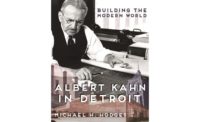John Yeon Architecture: Building in the Pacific Northwest
Edited by Randy Gragg, with essays by Barry Bergdoll, J.M. Cava, and Marc Treib

John Yeon Architecture: Building in the Pacific Northwest, edited by Randy Gragg, with essays by Barry Bergdoll, J.M. Cava, and Marc Treib. Andrea Monfried Editions, 240 pages, $60.
Architects & Firms
John Yeon (1910–94) might be the most important architect you’ve never heard of. He was self-taught and produced a small body of work, completing only 18 of the 65 buildings he designed. He wasn’t even licensed. Yet he developed a distinctive style of regional modernism, featuring a planar simplicity and use of local materials, techniques, and vernacular forms, that responded to the Pacific Northwest climate.
The work can now be appreciated through an excellent monograph published to coincide with a retrospective, Quest for Beauty: The Architecture, Landscapes and Collections of John Yeon, held at the Portland Art Museum from May 13 to September 3. Randy Gragg, editor of the monograph and executive director of the John Yeon Center for Architecture and Landscape at the University of Oregon, was a cocurator.
The son of a timber magnate in Portland, the young Yeon interned in the office of a local architect and took courses at the Portland Art Museum School from landscape painter Henry Wentz. Yeon and his friend Pietro Belluschi often visited Wentz’s painting studio on the slopes of Neahkahnie Mountain. As Yeon recalls, the balloon-framed cabin, with walls of spruce lap siding, was “the first really beautiful piece of architecture” he had seen in Oregon.
In 1928, the 17-year-old attended Stanford briefly before heading to New York, where he worked at an architecture firm and became acquainted with such influential New Yorkers as Alfred Barr, Philip Johnson, Lincoln Kirstein, and Edgar Kauffman, Jr. In 1930 he returned to Portland and was appointed to Oregon’s first State Park Commission.
Fellow parks commissioner Aubrey Watzek, another timber heir, hired Yeon, then 26, to design a house. The elegant courtyard scheme with pitched roofs and clad in tongue-andgroove Douglas fir was organized on perpendicular axes to choreograph views of mounts Hood and Saint Helens.
After the house was completed in 1937, Henry-Russell Hitchcock, the architecture historian and frequent curator for New York’s Museum of Modern Art, visited it. Subsequently, the Watzek house appeared in MoMA’s 1939 catalogue and show Art of Our Time: 10th Anniversary Exhibition. Editors and curators on the East Coast were drawn to “Yeon’s distinct and restrained aesthetic of wood architecture in taut dialogue with its local landscape,” as architecture historian and MoMA curator Barry Bergdoll writes.
Yeon went on to build other houses, but by 1955 he stopped to devote himself to land conservancy in Oregon, curating museum exhibitions, and collecting art. Nonetheless, he deserves a place in history for pioneering a regional response to the stringently pure International Style. Marc Treib, professor of architecture emeritus at the University of California, Berkeley, compares Yeon’s minimal, woodsy style with that of William Wurster and others in Northern California and concludes, “Yeon had blazed the trail.”




